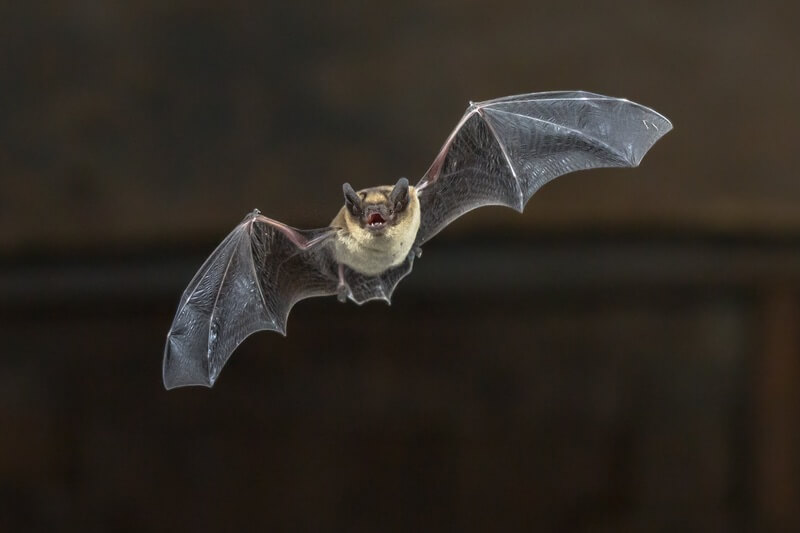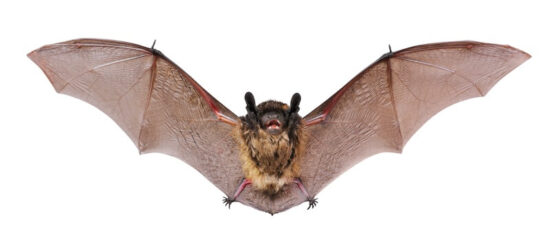For some people, figuring out how to keep bats away is a top priority. Whether it’s fear of disease or a general dislike of the animal, this sentiment isn’t uncommon.
So how do you do it?
This guide will teach you how to deter bats and scare them away from your property in humane and efficient ways.
Table of Contents
How To Keep Bats Away From Your House
Keeping bats away from your property is no easy task. These night-dwellers often remain hidden , waiting until the sun goes down to enter your domain and possibly spread disease.
But even though it’s challenging to deter bats, here are a few useful tips worth trying.
1. Take Advantage Of Essential Oils
If you’ve spotted a few stray bats flying around your property, you can try using essential oils to keep them away.
Like many other pests, bats despise essential oils. While we humans often find those scents nothing but pleasant, bats have a much stronger sense of smell. The already-concentrated aromas are far too much for the animal to handle.
As a result, many bats will avoid essential oils as much as possible. They will stay out of the area to keep their noses from smelling those strong scents.
Which essential oils should you use? Realistically, anything with an overwhelming smell will do.
That said, homeowners typically see success with cinnamon, eucalyptus, peppermint, and cloves. Fill a spray bottle with clean water and add several drops of the essential oil. Give it a good shake, and your solution is ready to use!
You can apply the oil spray to any areas you see bats active. If you have an animal coop outside, use it along the edges of the perimeter. You can also spray it on your roof eaves or any potential hangout spots that bats use.
Keep an eye on the bat’s activity for a few days. Figure out where they go on your property and focus your spray there.
2. Use A Net
Nets are a fantastic way to keep bats away from specific areas. There’s a good chance that you won’t be able to net your entire backyard, but this simple trick works wonderfully if you have particular areas that could attract bats.
As you probably know, bats don’t have the most robust sense of sight. They rely on echolocation to navigate the night sky.
Bat nets are just the right kind of invisible! The webbing is difficult to pick up using echolocation and other navigational methods, so many will fly directly into it.
You can set nets up around critical areas. For example, many people use them over the top of chicken coops and other animal housings in order to deter these creatures. If you have fruit trees that bats love to snack on, you can toss the net over the entire thing.
When they get into the net, bats often panic until they get out. Once they manage to wriggle themselves free, they’ll learn to avoid that spot in the future.
3. Set Up A Decoy Bat Home
Here’s a trick that seems counterproductive. How is setting up a dedicated house supposed to keep bats away?
The goal here is to strategically control where the bats go. In most cases, bats venture into your property to seek shelter and safety. That’s how bats end up living in roof eaves and attics. They find a good place to live and stick around longer than they should.
When you use a decoy bat house, you can encourage them to stay off your property by providing them with an alternative. Set one up just outside your property line. If that’s not an option, installing one in a tree off to the corner of your yard works as well.
Bats love to take advantage of well-built houses. They often prefer these purpose-built structures over other living areas they must modify.
Decoy bat houses are regularly available at most home improvement stores. They’re easy to build and come with guidance on where to hang them. Follow those directions, and you’ll have a structure that keeps bats away in no time!
4. Place Aluminum Foil In Busy Areas
Aluminum foil is an underrated tool when it comes to keeping bats away.
The shiny stuff you keep in your kitchen is surprisingly effective against bats and other pests. It works to keep bats out in a couple of different ways.
First, hanging it up high next to potential bat hangout spots will create reflections that scare bats away. Aluminum foil isn’t as reflective as a mirror but can bounce light in all directions.
The effect scares bats off, leading them to believe that there’s human or predator activity nearby.
If the bat braves the confusing light and gets close, it’ll interact with the foil directly. What happens when you touch aluminum foil? It crinkles and makes tons of noise.
Once again, that’s an experience bats aren’t used to. Most will flee when the crinkling starts, mistaking the foil for something far more nefarious!
Put the aluminum foil in areas that bats like to frequent. Pay close attention to potential entry points.
5. Reduce The Amount Of Food & Water On Your Property
In addition to shelter, bats venture into your yard for food and water. You may not realize it, but your property could offer the perfect survivability trifecta!
Bats eat many different things. Before you start considering a yard shakedown, do some research about the bats in your area. Knowledge is power, and knowing what kinds of bats you’re up against can help you be more strategic about how you keep them away.

These animals eat many different kinds of bugs. They love to chow down on beetles, moths, and mosquitoes. It’s impossible to get rid of every bug in your yard, but you can take steps to reduce insect populations.
For example, you can use pesticides and other chemical treatments. Natural alternatives exist, too.
For mosquitoes, you’ll need to set up traps and eliminate water sources the bugs use for breeding. You can use zappers and other trapping devices to get rid of moths.
Getting rid of those bugs can make a big difference.
In addition to insects, many bat species like eating fruits and flower nectar. If bat issues are a serious concern, you might want to think about removing fruiting plants and flowers entirely to remove all possible attractants.
6. Try Some Lights
If there’s one thing that movies have taught us, it’s that bats hate light! These animals are nocturnal, and they spend the day resting until nightfall.
You can use that fact to your advantage with some powerful lights. There are many approaches here. You could set up motion-activated lights in areas where bats like to frequent, but your results will likely be hit or miss.
The best way to use powerful lights is to point them directly on or inside their resting spot. Do this at night when the bats are out hunting for food. Set your lights in the hiding spot and point them towards the ceiling (most bats hang upside down as they rest).
Turn the lights on, and the bats will be in for a nasty surprise when the sun comes up, and it’s time to rest. For the best results, get strobe lights. Those party lights repeatedly flash, creating an even more appealing setting.
Upon returning to their hiding spot, bats will have no choice but to flee and search for somewhere else to roost.
7. Make Some Noise
It’s not just light that will keep bats away. Loud noises are problematic for them as well.
Remember how we said that bats use echolocation to navigate the night sky? Well, bats have a strong sense of hearing that goes beyond the capabilities of humans. They listen to frequencies outside the range of human hearing.
Use that fact to your advantage!
Noise-emitting devices are a fantastic way to repel bats without disturbing the entire neighborhood. There are many bat-specific models out there, and the way they operate is rather straightforward.
All you have to do is set up the devices outside. Grab a few to set up a perimeter. Then, turn them on at night.
Noise emitters produce a high-pitched sound that’s outside the range of human hearing. You won’t hear anything, and most animals won’t, either. But to the bat, it’s a deafening sound they’ll want to avoid at all costs!
8. Try A Bat Repellent Product
If all else fails, you can use bat-repelling products.
These products aren’t as widespread as mouse and rat repellents. But if you live in an area constantly dealing with bat issues, you’ll likely see them in local stores. Or, you can buy them online!
Either way, commercial bat repellers work well to keep these animals away. Most utilize chemicals that create a strong smell. Some use essential oils and other pungent ingredients. Others will use chemical disinfectants like phenol.
Applying the repellent is easy. Like the essential oil tip we covered earlier, spray the product on well-known bat hangout spots. You can use it on existing nests, roof eaves they might sit on, and any other hiding spot they might use.
Once the product is in use, you’ll notice that most bats will likely stay away from your property.
Is It Really Worth Trying To Keep Bats Away?
Before you use these tips, it’s worth considering if keeping bats away is a good idea in the first place.
These creatures have a bit of an unfair reputation. They’re horror icons, and the close connection to mythical vampires makes many people fear them. While they certainly look scary, bats are relatively harmless!
They’re more scared of you than you are of them. It’s rare for bats to get up close and personal, and most of the common species you encounter in your backyard aren’t out for blood!
In fact, bats do a lot of good. They’re one of Mother Nature’s finest bug exterminators. You might not realize their impact, but bats do a lot to keep pest numbers down.
Deterring them and making your property bat-free could lead to an uptick of bugs.
Ultimately, the choice is up to you. There is always a possibility that bats could spread disease and become a nuisance to other animals. They’re also problematic if you have fruit trees and flowers.
But beyond that, they’re harmless. Assess your situation and think about whether you should go to the trouble. If the bats are not bothering beyond the creep factor, it may be better to let them be.
How To Keep Bats Out Of Your House
Whether or not you keep bats away from your property is one thing. But allowing bats to get into your house? There’s no question that having these critters inside your home is something you can’t have!
If you’re worried about finding these animals inside your place, use these tricks to keep them out.
Find Out How They’re Getting In
The first step in addressing this problem is figuring out how these little pests are getting into your home in the first place! This can be tricky. Bats are difficult to track due to their nocturnal nature.
Pay close attention to noises you hear at dusk and dawn. Bats usually go into hiding when the sun comes up. They settle down, get comfortable, and sleep throughout the day before leaving to hunt for food at dusk.
You may hear rustling and chirping during those critical sun-up and sun-down periods. Use that as your first clue as to how they’re getting in.
Then, look around for guano, also known as bat droppings. Guano usually builds up on walls and ledges near the entry point. You’ll likely smell it, too!
Use all those clues and your observation skills to figure out how these pests get in. The most common entry points are chimneys and vents. Many also use roof eaves, ridge caps, and other vulnerable roof points.
You may also have weak siding that the bats are squeezing in. Keep an eye out for all those spots.
Close Up The Opening
After you find how these pests are getting in, it’s time to seal those openings so you can keep the bats away.
Before you do that, consider giving the bats a few days to vacate. You can adopt some of the tricks from earlier to make the entrance point as unappealing as possible. One-way exit devices are also available to help any stray bats inside your home vacate the premises before you seal things up.
After a few days, cover opening the bats take advantage of.
For chimneys, invest in caps, covers, and screened vents. Screen material will come in handy during this sealing process. It’s a great material when dealing with entrance points that must remain open for ventilation. Screens let the air in but will keep the bats out!
If the bats used broken siding and other repair issues, fix them. Sealants and caulks can work, too.
Remove Food & Water Sources They Can Access In The House
To prevent future issues, make your house unappealing to bats.
The reason why bats enter homes is that they want food and water. Once they find it, they realize that your home is the perfect place to rest during the day. Before you know it, those in-home hiding spots become roosting areas.
To prevent bats from entering at all, remove all food and water. That doesn’t mean ditching your refrigerator and emptying the pantry. However, it would help if you made all the food and water inaccessible.
Use airtight containers and avoid keeping food out on your counters. If you have a pet, clean empty dishes at night so that bats don’t use them while your pet sleeps. Don’t forget to look around for water leaks and other unknown food and water sources your house might have.
Clean Up
After you scare away all of the bats, clean your house thoroughly. We’re not talking about a quick wipe-down. You must go the extra mile, scrub the areas they lived in, and use as much disinfectant as you need to rid the place of bacteria.
Bats can carry diseases. Their dropping also contains a fungus that can create life-threatening respiratory problems.
Don’t take this task lightly. If it’s within your budget, we always recommend professional cleaning. You can’t be too careful about bats and what they leave behind!
Conclusion
As you can see, learning how to keep bats away isn’t as hard as it seems! These animals are far more afraid of you than you are of them, so all it takes are some efficient deterrents to get the results you want.
If you’re having an issue with bats and can’t seem to solve it, let us know! We’re happy to weigh in and provide some suggestions.


